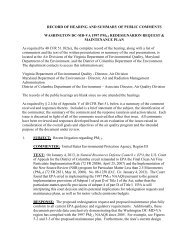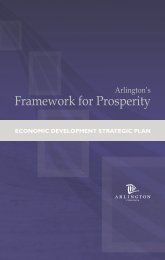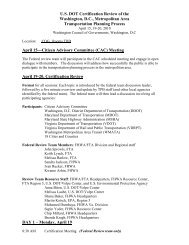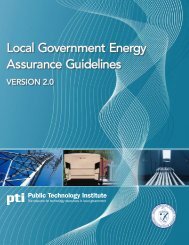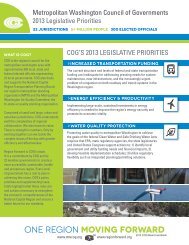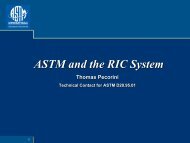Calibration Report for the TPB Travel Forecasting Model, Version ...
Calibration Report for the TPB Travel Forecasting Model, Version ...
Calibration Report for the TPB Travel Forecasting Model, Version ...
Create successful ePaper yourself
Turn your PDF publications into a flip-book with our unique Google optimized e-Paper software.
<strong>Calibration</strong> <strong>Report</strong> <strong>for</strong> <strong>the</strong> <strong>TPB</strong> <strong>Travel</strong> <strong>Forecasting</strong> <strong>Model</strong>, <strong>Version</strong> 2.3<br />
1.3.4 Subdivided non‐home‐based purpose<br />
Whereas <strong>the</strong> <strong>Version</strong> 2.2 model uses a single Non‐Home‐Based trip purpose, <strong>the</strong> <strong>Version</strong> 2.3 model<br />
disaggregates NHB travel among two sub‐purposes: Non‐Home‐Base Work (NHW) and Non‐Home Base<br />
O<strong>the</strong>r (NHO). This change was also in line with consultant recommendations. 10 <strong>TPB</strong> staff felt that <strong>the</strong><br />
observed differences between <strong>the</strong>se travel markets in terms of trip rates, trip lengths, modal<br />
preferences, etc. were substantial enough to justify establishing an additional purpose. <strong>TPB</strong> staff<br />
considered making o<strong>the</strong>r splits of trip purposes (e.g., separating out home‐based school trips from<br />
home‐based o<strong>the</strong>r trips), but ultimately decided to defer making any fur<strong>the</strong>r splits of trip purposes at<br />
<strong>the</strong> present time.<br />
1.3.5 Refined non‐motorized travel<br />
The <strong>Version</strong> 2.3 model includes <strong>the</strong> development of non‐motorized trips 11 <strong>for</strong> all (work and non‐work)<br />
purposes. The <strong>Version</strong> 2.2 model develops non‐motorized travel <strong>for</strong> <strong>the</strong> HBW purpose only. Staff felt<br />
that <strong>the</strong> more detailed TAZ system would facilitate ef<strong>for</strong>ts to better reflect this particular travel market.<br />
However, <strong>the</strong> non‐motorized travel will be developed at <strong>the</strong> trip generation stage only.<br />
1.4 Overview of <strong>the</strong> <strong>Version</strong> 2.3 travel model<br />
A graphic showing <strong>the</strong> essential parts of <strong>the</strong> <strong>Version</strong> 2.3 modeling process is shown on Figure 2. Despite<br />
<strong>the</strong> general name <strong>for</strong> travel models (“four step”), <strong>the</strong> <strong>TPB</strong> travel model could more accurately be called a<br />
“six step” model. These six steps are described below.<br />
The demographic models are used to disaggregate <strong>the</strong> total number of zonal households across 64<br />
cross‐classes: 4 household income groups 12 by 4 household size groups (1, 2, 3, 4+ persons) by 4 vehicle<br />
availability groups (0, 1, 2, and 3+ vehicles available). The allocation of households to each cross‐class is<br />
made at <strong>the</strong> traffic analysis zone (TAZ) level. The figure indicates that peak‐hour transit accessibility<br />
measures are used as part of <strong>the</strong> demographic (vehicle availability) submodel step.<br />
The trip generation models are next applied to compute daily person trip productions and attractions by<br />
purpose. Five modeled purposes are modeled: Home‐Based Work (HBW), Home‐Based Shop (HBS),<br />
Home‐Based O<strong>the</strong>r (HBO), Non‐Home‐Based Work (NHW), and Non‐Home‐Based O<strong>the</strong>r (NHO). A<br />
commercial vehicle purpose (consisting of both autos and light duty trucks), and two truck types,<br />
Medium and Heavy, are also modeled. Medium trucks are those with two axles and 6 tires. Heavy<br />
trucks represent all combination vehicles.<br />
10 Cambridge Systematics, Inc., Fiscal Year 2010 Task <strong>Report</strong>s, Final <strong>Report</strong> (Washington, D.C.: National Capital<br />
Region Transportation Planning Board, November 16, 2010), 2–3, 2–12.<br />
11 Actually, “trip ends,” since <strong>the</strong>y are an output from trip generation.<br />
12 The income levels used approximate household income quartiles, based on <strong>the</strong> 2007 ACS.<br />
1‐8



